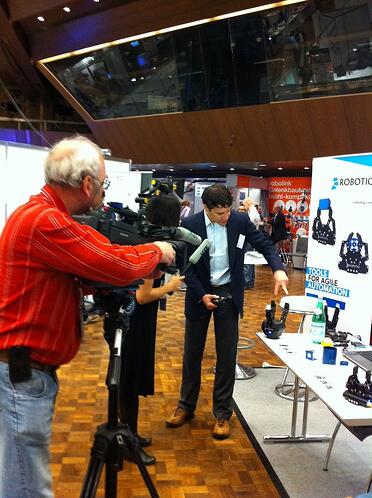ICRA 2013 : 7 Robotic Breakthroughs that will Change the Future

Posted on Jun 04, 2013 in Robotics
4 min read time
 The International Conference on Robotics and Automation 2013 (ICRA 2013) was held in Karlsruche, Germany from May 6th to 10th. The main sponsors were KUKA and Schunk, but all the major actors in robotics were showcased. Each year, various renown speakers are invited to present their research to the robotic community. Robotiq was there and we want to share with you the lectures that impressed us the most.
The International Conference on Robotics and Automation 2013 (ICRA 2013) was held in Karlsruche, Germany from May 6th to 10th. The main sponsors were KUKA and Schunk, but all the major actors in robotics were showcased. Each year, various renown speakers are invited to present their research to the robotic community. Robotiq was there and we want to share with you the lectures that impressed us the most.
Robert Wood, RoboBees: Progress in Insect-scale Robotics
Insect-scale robotics is a big challenge since screw and nut assembly is almost impossible. Robert Woods presented a fabrication technique in which pieces are cut as a whole including the assembly components. Once finished, it only needs to be folded and the assembly is done. This technique was very much appreciated by his students, as it avoided the requirement of working hours under a microscope on tiny assemblies. Moreover, it enables mass manufacturing. Learn more on RoboBees.
Alexander Waibel, Multi- and Cross-Lingual Robotic Assistants
The European Commission uses 23 official languages with everyone speaking their own, but still communicating in all 23 official languages. All this is possible due to the presence of translators on site. Nevertheless, this could be easier with a translation software such as Biggigo. Alexander Waibel presented this tool (available on Iphone and Android) but he also shared his vision on how computers and robotics would help future intercultural communications with the use of robot assistants. Learn more about the work of Alexander Waibel.
Yasuo Kuniyoshi, From Embodied Intelligence To Fetal Development - A Quest for The Fundamentals of Human-oid Intelligence
Yasuo, a theoretical researcher, explained to us, how he could predict natural behaviors in a human being simply by modeling muscular and neuronal systems. This way, they were able to foretell, from a precise psychological model, some behaviors of a human fetus. Learn more on the ISI Lab - Intelligent Systems and Informatics Lab.
Rodney Brooks, Rethinking Industrial Robots
Rodney Brooks is one of the men behind Roomba’s success. He explained to us how difficult it is for an engineer to think like a consumer. If we think that the consumer will not to do a specific thing, we must expect him to do it. In the same way, we must not ask ourselves if the customer will pay a certain price for our product, but how much he is willing to pay to fulfill his needs. This price should therefore always be in our mind when designing a product. This is how Baxter of Rethink Robotics is being developed.
Aude Billard, Teaching Robots to Cook, Relax and Play Catch
To catch a flying racquet is not that easy for a human, so programming a robot to do so is much more complicated. Aude Billard explained how she succeeded with attractors and support vector machines. First, the possible grips on the flying object is taught to the robot and then they are used to parametrize the attractor. Then, the object’s dynamics are taught by demonstrating various throws. During the catch, the robot evaluates the object’s trajectory and moves towards a more convenient grip. This field of research will enable robots to have instantaneous reactions to perturbations similar to the way humans do. Learn more on the work of Learning Algorithms and Systems Laboratory at the École Polytechnique Fédérale de Lausanne.
Michael J Black, Visions of Motor Control: From Motion Capture to the Cortical Control of Movement
It is possible to deduce the desired movement of a human being by catching the motor neuron signals directly from the brain surface with electrodes. This technology could be able to give paralyzed people the ability to precisely control complex robotic prostheses. Michael also demonstrated for us how motor neuron signals can be used for object recognition. Indeed, our brain evaluates the best way to catch a desired object, then our motor neurons come into action. Learn more on Michael J. Black works.
Robotiq also had its own booth showcasing our Robotic Grippers. Here you see Jean-Philippe Jobin, co-owner of Robotiq, being interviewed.

For more information : ICRA's lectures








Leave a comment